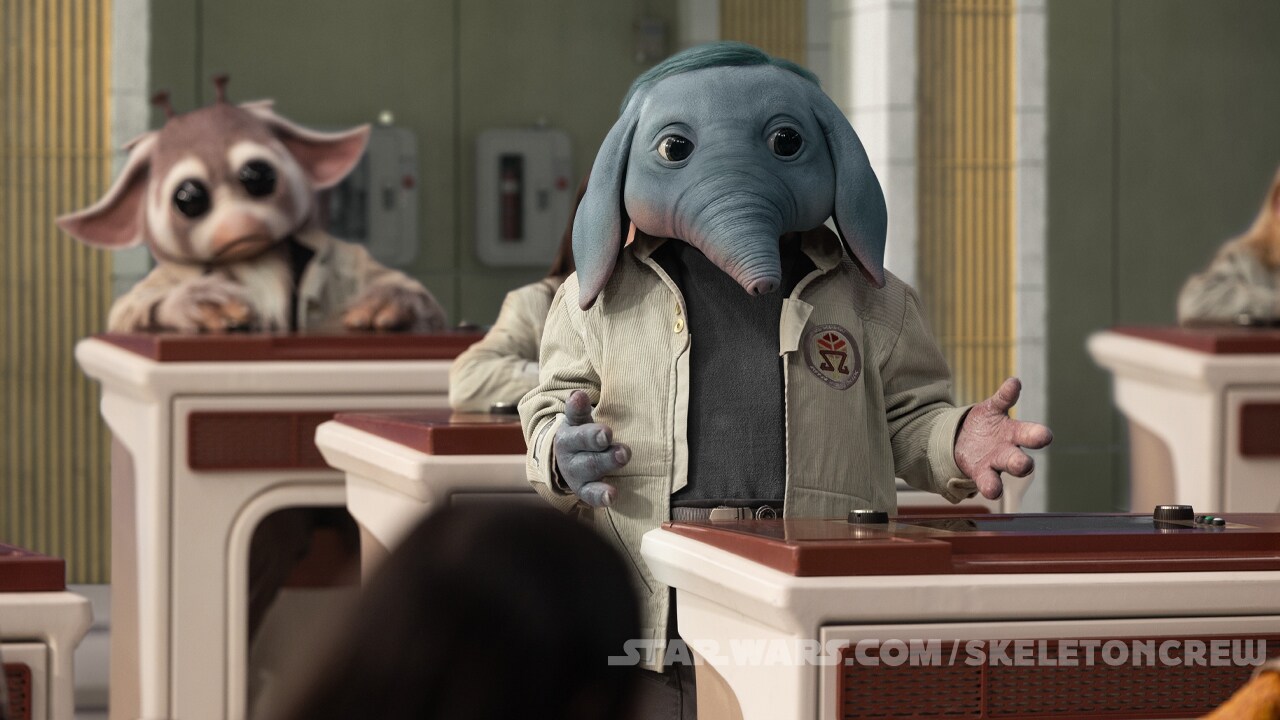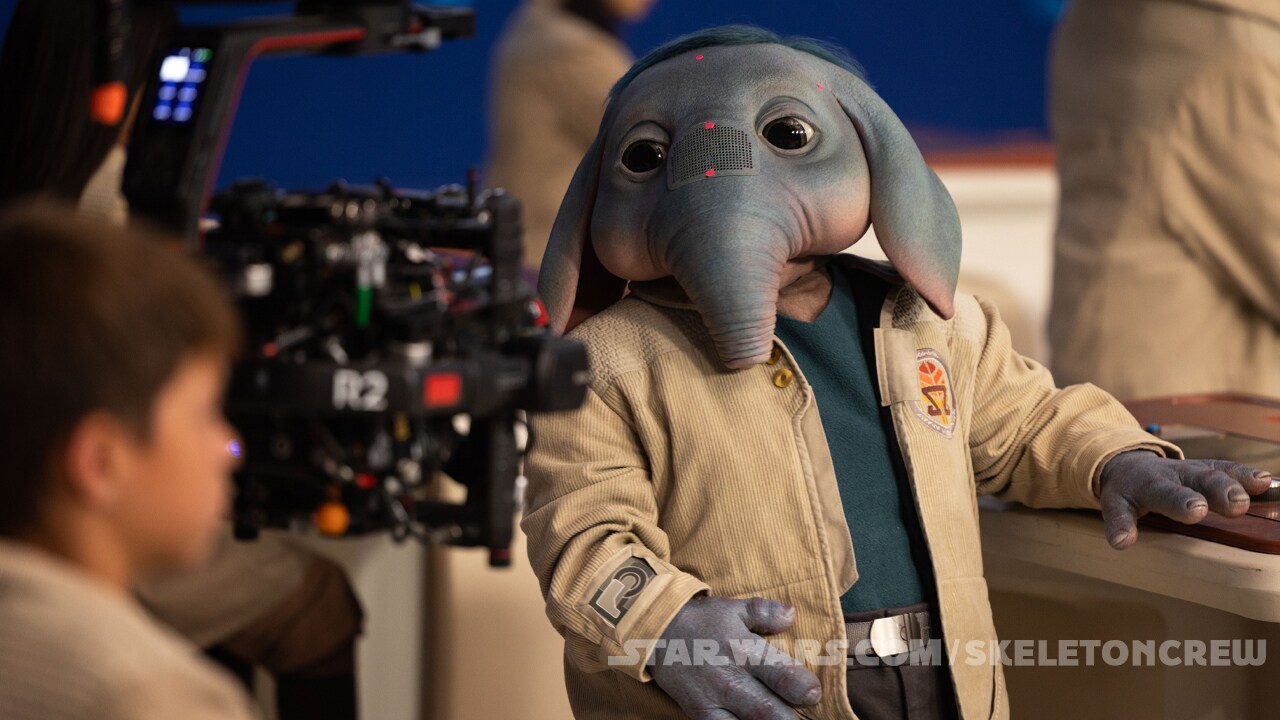They say it takes a village to raise a child. When it comes to Neel of At Attin, that old adage couldn’t be more accurate. It took the latest technology, a veteran special effects squad, an entire team of incredible performers, and one very dedicated young actor. But would you have ever guessed that the timeless proverb applies to droids as well?

Star Wars: Skeleton Crew, which recently debuted on Disney+, introduces a slew of brand-new characters who have already earned legions of fans. (Neel Nation, we see you.) “For Skeleton Crew there were more characters than we’ve built on any other season before,” says Legacy Effects co-founder J. Alan Scott, whose company fabricated Grogu for The Mandalorian and brought Professor Huyang and Murley the Loth-cat to life for Ahsoka among others. For the latest series, Legacy Effects once again made a mix of never-before-seen creatures and droids crafted by Doug Chiang and his production design team, like Neel and the unforgettable Kh’ymm, as well as more familiar aliens first glimpsed in other much-loved Star Wars stories.

For example: Pirate Captain Brutus, a scowling Shistavanen, is just one of the faces you might recognize, a member of the same species as a patron from a certain seedy cantina on Tatooine. “What’s great is that you see characters come back from the original series, creatures that were only hinted at before,” says Scott, practical effects supervisor for the series. “It’s always great to touch on those smaller characters that get a more enriched history.”
The loyal but intimidating droid SM-33 also bears some similarities to another beloved character. “SM-33 was a great new character because it harkened to K-2SO, kind of a similar aesthetic but with an old, decrepit, left-for-ages feel to it, which is great,” Scott adds.

Building SM-33
SM-33 presented some challenges for the effects team, not just due to his towering height in comparison to the show’s young cast. It was essential to the story that his relationship with Wim, KB, Fern, and Neel feel genuine.
“We had to come up with something that was much more interactive for the kids so that they could react to it,” Scott says. “It’s cliché, but it’s our job to be invisible, so that the director can just direct as if [the SM-33 puppet] was an actor. We just try to keep it alive and perform all the time so that it hones our skills, but also for the actors interacting with it, so that it becomes more of a colleague.”

Their efforts paid off. Actor Jude Law, who portrays the mysterious Jod, savored the challenge of having a puppet as a scene partner. “They had so much versatility, so much skill and influence over the characters that were either puppets or droids,” Law says. “The interaction isn't with the puppet or the droid. It's with the puppeteers and the people who are making it move and shake, or respond, or turn at the right time. And that's acting. It's just acting of a different kind.”
Scott and his team had a few tricks up their sleeves to bring the skeptical droid to life, including the latest technology in practical effects and CG, playing lines recorded by Nick Frost so the on-set actors could hear his actual voice, and even taking inspiration from a classic illusion. Designed to be controlled by a single performer, a lot of thought went into the materials used to piece a droid like SM-33 together.

“We came up with a good mix of a practical suit [and] puppet that could be a little bit of everything... In addition to making it lightweight, it has to be strong because it’s got to survive for a long period of time. It’s a delicate balance. With SM-33, his chest is actually transparent. [Performer] Rob Ramsdell can see through it, because another key part of having a convincing puppet is that you need to know your environment. You need to be able to see and interact with it.”

The old two-way glass trick, in which one side of the material reflects more light than the other, got the job done. “It looks like it’s solid metal from the outside, but you can see through it from the inside” Scott reveals. “It’s got rust and damage, and while you can’t see through all of it, there’s enough vision where Rob can put the pieces together and he can navigate the set so it doesn’t look like SM-33’s stumbling around. It’s a clear form of Vaccuform plastic, and we paint it like a two-way mirror. We keep trying to come up with those cheats so that we maximize our performance.”
Law was blown away by the result. “SM-33, in particular, was extraordinary,” he says. “Rob was finessing scenes so that you get a laugh at a certain moment. I remember there's one early on when Thirty-Three approaches Jod, and sort of questions him, prods him, lifts him up and all of that. We worked it out on the day and it was a whole new chapter in acting for me, working with these puppeteers and to that level.”

Team Neel Suits Up
As for Neel, the character design presented to the effects team with a new set of challenges, a simultaneously simple and yet very complicated question: How are we going to do that?
Capturing the proportions and mannerisms of a child required having a young performer inside the suit for some scenes. And actor Robert Timothy Smith was up for the challenge, adding his own whimsical gestures and provided facial capture that would enhance the character’s overall performance.

“We started exploring a whole bunch of different approaches. How much can Robert do? How much can he withstand as a performer, and how do we expose all of his face so that Jon [Watts] captures Robert’s facial performance and genuine reactions?” Scott says. “It ran the spectrum from let’s see all of Robert to let’s see all of Neel, and the in-between is where we worked together with every other department. It involved wardrobe, visual effects, and props. It was like, how do we create this so we’re building a suit that’s easy in and out, and unencumbering for Robert and eventually for [performance artist] Kacie Borrowman as well.”
Borrowman, who also lent her talents to Avatar: The Way of Water, stepped in to don the full animatronic head, designed with small perforations for her to be able to see the outside world. She studied Smith’s performances on set with a keen eye, and then the two worked closely together with a team of puppeteers to bring Neel to life.

“It became a tight knit group,” says Scott. “It’s like a band. You get in tune with Kacie’s performance and you can anticipate when she is going to look to the left, so you puppeteer the eyes and face accordingly. Jason [Matthews] puppeteered the eyes and Rick [Galinson] puppeteered the rest of the face, trunk, and ears. It becomes a small musical unit where they’re following each other’s lead.”
Not only was Borrowman able to step into a scene seamlessly thanks to her work with Smith, but the animatronic head itself was built to be as unobtrusive as possible. “What’s nice about animatronics and robotics is that it’s having a resurgence… [Neel’s head] is full of servos that are virtually silent, which we’ve never had before,” Scott adds. “Now we can be in a scene with two or three characters and our animatronics are moving and performing, and it’s not affecting the dialogue anymore.”

The Legacy of Legacy Effects
With extensive work on all three seasons of The Mandalorian, Skeleton Crew is far from Legacy Effects’ first Star Wars project. But for Scott and his practical effects team, contributing to the galaxy far, far away remains an opportunity that they never take for granted.
“I started in the Star Wars universe when I was 13, and I knew at 13 this is what I wanted to do,” he says. “So to have the opportunity to work on a Star Wars property, it’s full circle. You can just see the excitement when a new character comes in; you feel the elevation of the room because we grew up with this, but now we’re able to create it. There’s nothing like it. It’s really special.”
All episodes of Star Wars: Skeleton Crew are now streaming, only on Disney+.














